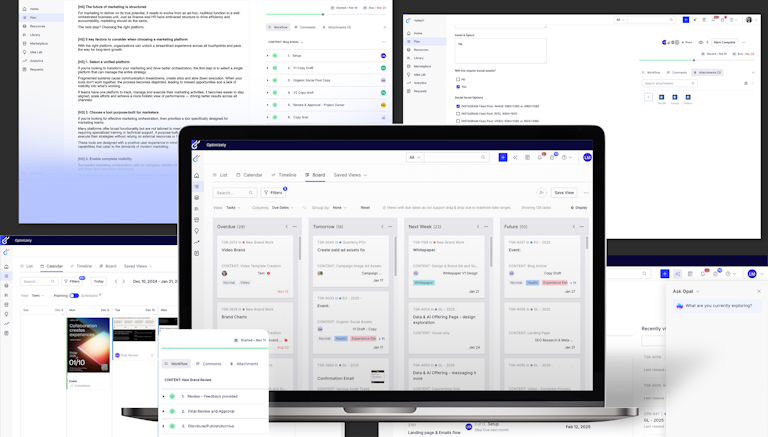In this Q&A, we look at:
-
Why marketing orchestration is a must for modern businesses.
-
Valtech’s own marketing orchestration journey.
-
What we learned about marketing leadership during an acquisition.
We will also highlight the five key factors to consider when selecting a marketing orchestration platform, and how we successfully leveraged Optimizely’s Content Marketing Platform (CMP) to transform our marketing efforts.
Whether you’re navigating a merger or scaling a global brand, this is your guide to orchestrating marketing that’s consistent, confident and built for growth.
Jump to a key section:
-
What is marketing orchestration, and how does it help businesses navigating transformation?
-
5 key factors to consider when choosing a marketing orchestration platform

Suddenly, there are two heads of digital. Overlapping campaigns. Conflicting metrics. Without clarity, chaos wins
- Optimizely Insights Team
The need for marketing orchestration
For marketing leaders, constant transformation is the norm. In a recent Gartner survey of nearly 400 CMOs, respondents said almost 40% of their total marketing budgets go to change and transformation initiatives — a clear signal of just how much organizations are evolving in real time.
Events are a microcosm of that complexity. According to Forrester, overall event satisfaction has dropped by 8% year-over-year, as teams struggled to meet new attendee expectations for personalized, interactive experiences.
Compounding the issue: More than a quarter of large enterprises are juggling six or more event tech platforms, and only 20% have integrated their primary platform into the broader marketing tech stack. But when they do, satisfaction rises, proving that orchestration can cut through complexity and deliver results.
At Valtech, we’ve faced these challenges firsthand. As a globally distributed marketing team, we needed a better way to collaborate, scale and measure impact. That’s why we turned to Optimizely’s CMP and why we’re sharing what we’ve learned here.

Marketing is growing in complexity — in terms of tech, data, execution and expectations. Orchestration gives us control in the chaos.
— Mattias Malmer, Global Head of Marketing, Valtech
Navigating silos and complexity
Marketing teams often juggle multiple tools, each built for various functions such as content creation, social media management, email marketing or analytics. This fragmentation leads to silos, a lack of visibility and disjointed messaging. Working in this way — without a unified system — makes it increasingly difficult to ensure brand consistency, measure ROI effectively or maintain clear stakeholder communication.
As marketing efforts become more intricate, challenges grow exponentially. With multiple campaigns running across various channels, regions and teams, marketers must navigate a multitude of dependencies. They need visibility into performance, the ability to react quickly to changing priorities and the structure to ensure consistency across touchpoints.
But in most organizations, marketing orchestration remains an afterthought. Teams operate in silos, tracking projects in isolated tools that don’t connect with each other.
The result? Missed opportunities, duplicated efforts and an inability to measure true impact.

In-house creative talent is essential, but without a structured approach its impact loses its value. As marketing grows in complexity, collaboration across global teams demands streamlined coordination. Online tools help navigate this complexity. Success is defined by integrating talent, technology and process in a unified system.
— Liza Maslovska, Global Content Project Manager, Valtech
Q&A: What is marketing orchestration, and how does it help businesses navigating transformation?
Marketing orchestration is the strategic coordination of campaigns, channels, data and technology to deliver personalized, consistent customer experiences at scale.
For businesses navigating transformation, it ensures every touchpoint — from brand storytelling to sales enablement — is aligned, agile and data-driven. This empowers the business to accelerate growth, break down silos and adapt quickly to changing customer needs.
Click through our marketing orchestration FAQ below for details:















